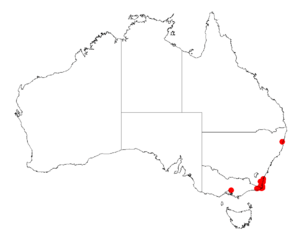Acacia subporosa facts for kids
Quick facts for kids Acacia subporosa |
|
|---|---|
| Scientific classification | |
| Genus: |
Acacia
|
| Species: |
subporosa
|
 |
|
| Where this wattle grows in Australia | |
Acacia subporosa, also known as river wattle, bower wattle, narrow-leaf bower wattle, or sticky bower wattle, is a special type of tree or shrub. It belongs to the Acacia family, which is a large group of plants. This wattle is only found in a specific part of southeastern Australia. It is considered quite rare in the state of Victoria.
What it Looks Like
This tree or shrub usually grows to be about 4 to 12 m (13 to 39 ft) (around 13 to 39 feet) tall. It can grow straight up, spread out, or have a rounded shape. It often has a low, wide top (canopy) that can be 20 to 30 ft (6.1 to 9.1 m) (6 to 9 meters) wide. Its branches often droop downwards and have smooth bark that is grey or brown.
Its small branches are a bit sticky and smooth. They have green to brown ridges that go up and down. Like most Acacia plants, it doesn't have true leaves. Instead, it has special flattened stems called phyllodes that look like leaves. These phyllodes are thin and smooth. They are shaped like a very narrow oval and can be slightly curved. They are usually 6 to 9 cm (2.4 to 3.5 in) (about 2.4 to 3.5 inches) long and 4 to 11 mm (0.16 to 0.43 in) (about 0.16 to 0.43 inches) wide. Each phyllode has two to five main veins and other smaller veins running along it.
The Acacia subporosa blooms between July and October, and sometimes even into summer. It produces pale yellow flowers. These flowers grow in round clusters, either alone or in groups of up to three, where the leaves meet the stem (called the axil). Each flower cluster is about 6 to 7 mm (0.24 to 0.28 in) (about 0.24 to 0.28 inches) wide and has 20 to 25 tiny flowers.
After the flowers, flat, firm, and smooth seed pods grow. These pods are long and thin, up to 7.5 cm (3.0 in) (about 3 inches) long. Inside, they hold shiny dark brown seeds. The seeds are shaped like an oblong (a stretched circle) and are about 4 mm (0.16 in) (0.16 inches) long. Each seed has a small, fleshy attachment called an aril at one end.
How it Was Named
The first official description of Acacia subporosa was made by a botanist named Ferdinand von Mueller in 1863. He wrote about it in his work called Fragmenta Phytographiae Australiae . At first, he spelled its name Acacia supporosa.
Later, in 2003, another botanist named Leslie Pedley reclassified it as Racosperma subporosum. But then, in 2006, it was moved back into the Acacia group. The first plant sample used to describe the species (called the type specimen) was collected by von Mueller himself from Twofold Bay in New South Wales.
The second part of its scientific name, subporosa, comes from the small oil glands found on its phyllodes. This plant is closely related to Acacia cognata and both are part of a group of wattles known as the Acacia verniciflua complex.
Where it Grows
This wattle naturally grows in coastal areas of southeastern New South Wales and northwestern Victoria. You can find it from around Bega in the north, all the way down to Howe Hill, which is on the northeastern tip of the Victoria-New South Wales border, in the far eastern Gippsland area.
It often grows along creeks and streams in valleys (gullies) or on low hillsides. It likes to be near the edges of rainforests. It grows well in moist, sandy soils or soils made from shale rock. You can often find it growing alongside another wattle called Acacia longifolia.
Growing it in Gardens
Acacia subporosa is sometimes used as a street tree or as a screening plant to create privacy. It can grow quite fast, about 24 in (610 mm) (60 cm) per year. These trees can live for almost 50 years! However, they can sometimes get sick with root rot, which affects their roots, or from tiny insects called shothole borers that bore into the wood.

